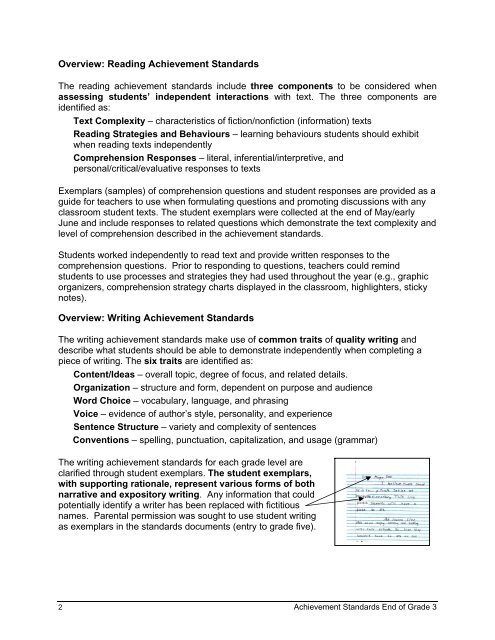Reading and Writing Achievement Standards Curriculum
Reading and Writing Achievement Standards Curriculum
Reading and Writing Achievement Standards Curriculum
You also want an ePaper? Increase the reach of your titles
YUMPU automatically turns print PDFs into web optimized ePapers that Google loves.
Overview: <strong>Reading</strong> <strong>Achievement</strong> St<strong>and</strong>ards<br />
The reading achievement st<strong>and</strong>ards include three components to be considered when<br />
assessing students’ independent interactions with text. The three components are<br />
identified as:<br />
Text Complexity – characteristics of fiction/nonfiction (information) texts<br />
<strong>Reading</strong> Strategies <strong>and</strong> Behaviours – learning behaviours students should exhibit<br />
when reading texts independently<br />
Comprehension Responses – literal, inferential/interpretive, <strong>and</strong><br />
personal/critical/evaluative responses to texts<br />
Exemplars (samples) of comprehension questions <strong>and</strong> student responses are provided as a<br />
guide for teachers to use when formulating questions <strong>and</strong> promoting discussions with any<br />
classroom student texts. The student exemplars were collected at the end of May/early<br />
June <strong>and</strong> include responses to related questions which demonstrate the text complexity <strong>and</strong><br />
level of comprehension described in the achievement st<strong>and</strong>ards.<br />
Students worked independently to read text <strong>and</strong> provide written responses to the<br />
comprehension questions. Prior to responding to questions, teachers could remind<br />
students to use processes <strong>and</strong> strategies they had used throughout the year (e.g., graphic<br />
organizers, comprehension strategy charts displayed in the classroom, highlighters, sticky<br />
notes).<br />
Overview: <strong>Writing</strong> <strong>Achievement</strong> St<strong>and</strong>ards<br />
The writing achievement st<strong>and</strong>ards make use of common traits of quality writing <strong>and</strong><br />
describe what students should be able to demonstrate independently when completing a<br />
piece of writing. The six traits are identified as:<br />
Content/Ideas – overall topic, degree of focus, <strong>and</strong> related details.<br />
Organization – structure <strong>and</strong> form, dependent on purpose <strong>and</strong> audience<br />
Word Choice – vocabulary, language, <strong>and</strong> phrasing<br />
Voice – evidence of author’s style, personality, <strong>and</strong> experience<br />
Sentence Structure – variety <strong>and</strong> complexity of sentences<br />
Conventions – spelling, punctuation, capitalization, <strong>and</strong> usage (grammar)<br />
The writing achievement st<strong>and</strong>ards for each grade level are<br />
clarified through student exemplars. The student exemplars,<br />
with supporting rationale, represent various forms of both<br />
narrative <strong>and</strong> expository writing. Any information that could<br />
potentially identify a writer has been replaced with fictitious<br />
names. Parental permission was sought to use student writing<br />
as exemplars in the st<strong>and</strong>ards documents (entry to grade five).<br />
2 <strong>Achievement</strong> St<strong>and</strong>ards End of Grade 3
















